cogpsychE1
1/142
There's no tags or description
Looks like no tags are added yet.
Name | Mastery | Learn | Test | Matching | Spaced |
|---|
No study sessions yet.
143 Terms
cognition
the mental act of knowing
goldstein definition of cognition
the mind creates and controls mental functions such as perception, attention, memory, emotions, language, deciding, thinking, and reasoning
the mind is a system that creates representations of the world so that we can act within it to achieve our goals
Marvin Chun definition of cognition / cog psych
cog psych seeks to understand how we come to know about the world and how we use that knowledge to make our way through it
the stroop task
involves seeing color words printed in a certain color. Task is to name the color that the word is printed in, not what the word says
measures our ability for cognitive control
reconfiguring information processing to achieve novel tasks
Pareidolia
the psychological phenomenon of seeing meaningful patterns, especially faces, in random or ambiguous stimuli, such as clouds, toast, or the moon
Muller-Lyer illusion
lines appear to be different lengths despite being the same length.
explanation: interference of depth
Plato: is the mind a blank slate?
arriving at the right answer through socratic method after initially being wrong implies there was knowledge existing, person just needed to be guided to it
ancient greeks were NOT the first cog psychologists bc they were philosophers not scientists. they wanted to understand the nature of knowledge
Donders
first person to quantify cognition through reaction time experiments
donders reaction time experiments
stimulus —> mental response —> behavioral response
light flashes —> percieve light —> press button
time from stimulus to behavioral response is the reaction time
left light flashes —> perceive left light AND decide which button to push —> press left button
again time from stimulus to behav response is reaction time, but this time with an added cognition step
take difference of two reaction times to isolate cognitive processing time
wilhelm Wundt and structuralism
“the father of psychology”
structuralism:
cognition is a combination of basic elements (sensations)
we find them through analytic introspection (observe own thoughts)
what are the core elements/processes/sensations you are experiencing
downsides of structuralism: subjective and unreliable, elements not visible
Behaviorism
did not like introspection (structuralism) bc not reliable and elements are invisible
focus on:
observable and measurable behaviors
stimulus-outcome associations: present stimuli, see what happens, measure outcome
believed there is no need to study the mind
John Watson (behaviorist)
little albert experiment:
unconditioned stimulus = loud sound
neutral stimulus = seeing bunny, no fear
conditioned stimulus = seeing bunny
conditioned response = fear upon seeing bunny, despite no loud sound
EXPOSURE to neutral stimulus
LEARNING: pair stimulus with loud sounds (unconditioned stim)
CONDITIONING: be aversed by that object bc of loud sound (bunny scary now even tho no loud sound)
john watson believed that u can take a healthy baby and condition it to become anything u want using stimulus outcome associations
B.F Skinner (behaviorist)
operant conditioning:
behavior followed by reward = increased behav
behavior followed by punishment = decreased behavior
Edward Tolman — return of cogniton
experiments on rats, see how they respond to rewards. but NOT in a behaviorist way
Initial exposure:
let rat run around to learn maze layout
learning phase:
put food reward in one arm of maze every time, rat learns to run to get the food reward
test:
put rat in different arm of maze to start, which way will it go?
—> behaviorists would say operant conditioning would lead the rat to continue to travel in the same path it has been traveling in
BUT
rats actually knew where reward was and changed its plans towards this goal
—> rat was able to make decisions in new situation it had never seen before, so we must think about the mind and internal processes we cant observe
Edward Tolman —- Introducing Cognitive Maps
internal model of the world maintained in our mind
not directly observable, but is inferred
break with pure behaviorism!
the cognitive revolution - mind as an information processor
began w introduction of the digital computer
computer as analogue for the mind
input —> many computations/processing —> representation (storage)
broadbent model of mind as an information processor:
inputs —> filter —> detector —> to memory
example of a box and arrow model of the mind
modal model of memory: sensory input —> sensory memory (unattended info is lost) —> short term mem (unrehearsed info is lost) ←retrieval→ long term memory (some info may be lost over time)
3 types of information processors
serial: one computation at a time
parallel: multiple processes at the same time, governed within the system
distributed: multiple, self-acting processes
serial information processor
can only perform one computation at a time
time to do computation = number of steps it takes to do computation
burger restaurant example:
one chef who can only make one burger at a time
time to make 5 burgers = 5 * time to make 1 burger
parallel information processor
multiple processes at the same time, governed within the system
time to do computation = time to do one computation
ramon y cajal staining neurons:
showed that they werent serial, they can run many processes at once
burger example:
burger assembly line of many chefs directed by head chef, each making one burger at a time
time to make 5 burgers = time to make 1 burger
distributed information processor
multiple self acting processes
independent parallel systems, nothing telling them what to do
burger example:
4 agents doing burgers, nobody telling them what to do. they are just doing steps until they finish their task. then they look at the environment and see if there is anythign more to do. if not, cease action
representation
an internal symbol that represents an external reality
something that stands for an experience
3 types:
language
network
map
we use the representations that are driven by what is useful to us. humans are super social so faces are important —> specialized regions of brain to proces faces
to bats faces arent important —> sound more imporant
language representation
represents the information in words
network representation
in your memory, independent nodes that represent things that are related to each other through associations
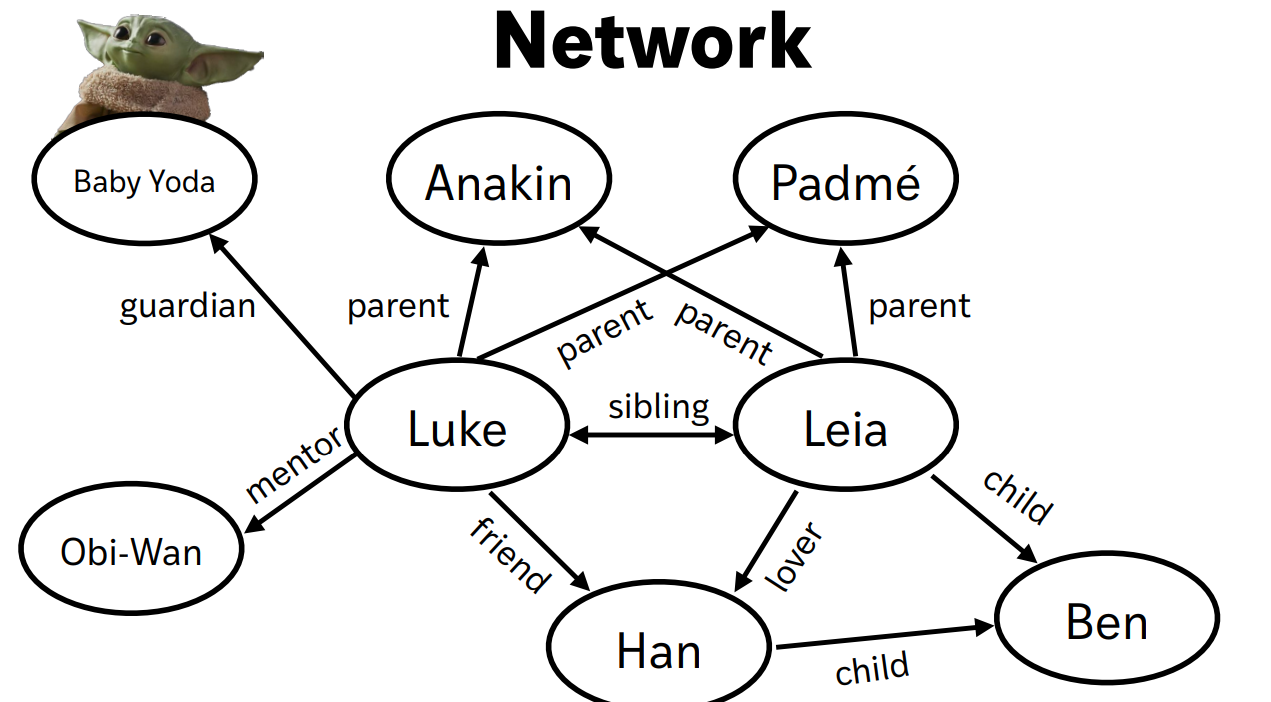
Map representation
function that maps a dimension in the world to a dimension in the representation
f(dimension in world) = dimension in representation
ex scale maps weight into a number
Survival-Moving study —> evolution constrains cognition
selective pressures/problems shape the operating characteristics of our system
shown list of words and one of 3 encoding conditions:
survival condition:
rate how relevant these words would be in a survival situation
moving situation:
rate how useful these words would be to u if u were moving to a foreign land
pleasantness:
rate how pleasant the words are
result —> survival encoding condition led to best memory performance
we have more memory for survival, even tho we are more likely to move than to survive —> cognition shaped by evolution
mental rotation study —> shows how evolution constrains cognition
see pairs of objects and figure out how to make the 2nd one eaqual to the 1st
we solve these using rotation in dimensions that our brains have experienced
causes problems when it requires a dimension we havent experienced
Levels of explanation— what is the right level of explanation at which to explain behavior?
information processing levels of explanation:
computational
what is the problem to be solved
algorithmic
what are the steps to solve it?
implementational
how does the brain do it?
biological levels of explanation:
whole behaving organism
loves
brain areas
neurons
plasticity:
can behavior control the brain? —> yes!
ex: blind ppl learning to use echolocation
areas that are typically dedicated to vision now process auditory info
fMRI shows activation of visual cortex in response to sound
** early blind had more light up than late life blind ppl
reductionism vs multi-level approach —— levels of explanation
reductionism:
explain how bottom (neurons) explains top (behavior)
too simple, we know that it can go the other way around bc plasticity
multi level approach: —> better!
interactions from top to bottom and bottom to top
the neuron doctrine
the idea that individual discrete cells transmit signals in the nervous system, rather than a continuous nerve net
hierarchy of brain organization
brain —>
cerebellum, cortex, midbrain, brainstem
—> lobes of cortex
—> areas
—> neurons
neuron
cell consisting of celll body (maintains it), dendrites (appendages to cell body that recieve information), and axons (sends info from the neuron)
brain previously thought to be big neural net, but ramon y cajan neuron staining showed that its individual neurons —> neuron doctrine
RECEPTOR NEURONS:
stimulus → receptor → axon
have no dendrites
AP:
resting -70
impulse +40 peak
goes back to resting pot
neuronal action potentials
dont increase in intensity based on stimulus intensity. it is an all or nothing response
threshold -55 mV
resting -70
stimulus
threshold
depolarizatoin —> peal +40
repolarization
refractory period and drops below -70
comes back to resting state
how does neruonal AP occur?
there is synapse wher receiving cell body/dendrites and axon meet
AP arrives, vesicles in axon containing neurotransmitter released into synaptic cleft of synapse, neurotransmitters bind to dendrites of rec cell, changing electrical charge of rec cell
Inhibitory synapse
decreases the charge of the post-synaptic cell, reduces likelihood that will overcome threshold for AP
GABA and GABA receptor
Cl- rushes in —> negative charge of cell
excitatory synapse
increases the charge of post-synaptic cell, increases likelihood that will overcome AP threshold
glutamate and NMDA and AMPA receptors
lets in Na+ and Ca2+
brain area
a patch of cortex that has one particular function
visual cortex and its areas
visual cortex is contralateral = right visual field is processed on left side of brain and vice versa
early areas of the VC do simple things —— Hubel and Wiesel cat V1 studies
Hubel and Wiesel Cat studies about V1
record from specific neuron in V1, show it lines with differnt orientations andlocations
neuron in cat V1 encodes edges that
have a particular orientation
appear in a particular location of the visual field
—> early VC is very specific and encodes things in a topographical representation
aka a RETINOTOPIC MAP
f(closeness to preferred location, closeness to preferred angle) = firing rate of neuron increases
lobes
occipital (visual)
temporal (auditory, objects, memory (hippocampus is behind it)
parietal (attention, orientation)
frontal (thinking, reasoning, decision making, etc)
grey vs white matter
grey matter = cell bodies, dendrites, axons, axon terminals
outside parts of brain
white matter:
long--range axons, myelin
gyri and sulci
gyri = protrusions
sulci = valleys
create wrinkles in brain cortex
gives more surface area for cortex AND relative distance between areas is closer, so faster communication
major regions of the brain
cerebellum = we dont give a shi ab this
brain stem
cerebral cortex
using isotopic fractionating = turn brain into soup (homog mix of cells bodies) , stain, then count nuclei —> tells us how many neurons in a region
V1 = 280 million
cortex = 16 billion
cerebellum = 69 billion
whole brain = 86 billion
cerebellum has mad neurons, yet we ignore it in cog psych i guesss?
neural representations
how neurons represent the world
3 ways of coding:
specificity coding
population coding
sparse coding
specificity coding (neural representations)
one to one representation (one neuron for each thing ever)
cons: not enough neurons for this, cant think ab similarities/associations
population coding (neural representataions)
all neurons involved in the representation, but it is a distrbution
cons: number of possible representations is limited
sparse coding (neural representations)
set of neurons that represent certain things, others are quiet. a distribtuion, but not every single neuron is involved in this distribution
how are recordings taken directly from the cortex
electrocorticography
array/grid of electrodes on the cortex
can try to find neurons that respond to specific things
WARNING: not every cog fn or represtnation can be located to one particular brain area
most of the time, cognition is driven by distributed or parallel process across entire brain
distributed neural networks
looking at resting state data, we can see which regions covary with each other
we can also look at this when ppl are doing stuff
distributed neural functions
somato-motor, visual, saleince, executive control, dorsal attention
default mode network
can we infer causality?
Hubel and Wiesel experiment showed that area V1 represents edges and oreintations: TRUE
hubel and wiesel experiment showed that area V1 causes perception ofedges and orientations?: FALSE
just bc one region correlates w that, doesnt mean that it caused its perception
there might b a downstream region that causes perception
motion perception case study to make causal inferences
area MT of VC, selective to motion in the contralateral field
isolate area MT by having person look at field of moving dots w different levels of coherence
first step: find neuron that cares ab one particular direction
show 100% coherent motion
find neuron that responds strongly to one direction of 100% coherent motion
record neuron while varying direction and coherence —> rules out that it responds strongly to everything
results:
neuron spikes the same regardless of coherence when motion is in opposite direction
neuron spikes more with increasing coherence for preferred direcional orientation
so: is it involved in perception tho? —> stimulate this cell while monkey responds to the movement in the cells preferred direction
bias towards that direction
with stimulation, monkey is more likely to report motion in the preferred direction, even if there isnt motion in that direction
Haemodynamic response (neuroimaging)
when neurons fire, they require energy (glucose/oxygen) and consume it
record oxygen in blood
stimulus, slow esponse, initial dip in oxygen (using it up)—> then peak (brain oversupplies that part of brain w oxygen) —> post stimulus undershoot
very slow and can be measured easily using PET or fMRI
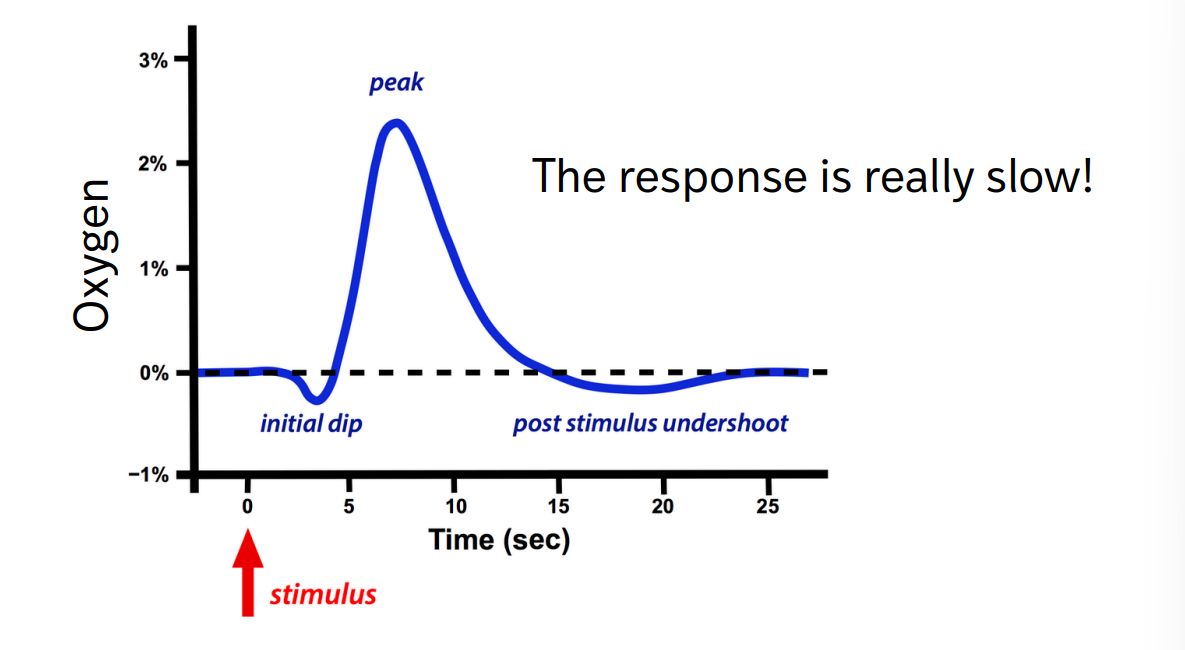
positron emission tomography (PET)
uses radioactive tracer to measure haemodynamic response — measures blood flow/metabolism
spatial resolution = 1 cm
temporal = 0.5 min
radioactive tracer on oxygen
positron hits electron —> photons
ohotons travel in opposite directions and hit detector
small differnce in timing reveals location
first neuroimaging of cognition in humans!
functional magnetic resonance imaging (fMRI)
based on magnetic properties of blood oxygen (no radioactive tracer) to measure blood oxygen level (haemodynamic response)
spatial resolution = 2 mm
temporal = 2 sec
better than PET spatially and temporally, but MAD expensive
electroencephalography (EEG)
does NOT measure haemodynamic response —- measures electrical activity of brain directly
based on electrical properteis of the brain
measures chagne in voltaeg across groups of neurons
wayyyyyyyyyyyy cheaper than fMRI
spatial resolution = 8 cm (not great…)
temporal solution = 1 ms (MAD fast)
Flanker task —- measured using EEG
left or right button press to indicate which way middle arrow points
neutral trials = flankers dont interfere
congruent = flankers match
incongruent = flankers dont match
more errors
error related negativity tracks cognitive control:
garph showing potential vs time after stim onset
congruent and incongruent plots differ at 200-300 ms
at this pt, incongruent trials have a more negative potential, congruent have more positive potential
this reflects how much conflict the brain is experiencing
more incongruent = more conflict = more errors = more negative potential
neural circuits
groups of interconnected neurons
if kittens are raised in an evnironment that contains only verticals, you would predict that most of the neurons in their VC would respnd best to the bisual presentation of a
chain link fence
solid wall
picket fence
brick wall
naturally occurring lesions
brain lesiosn due to disease and injury
causes:
trauma
stroke
bleeding
tumor
neural disease
scotoma in visual cortex (lesions)
lesions in occipital lobe, specifically visual cortex
if damage is in left occipital lobe (calcarine sulcus) —> visual abnormality in the right visual field
how can we use lesions to understand cognition?
they can help us identify neural substrate of a particular function
but we need to be very careful
must use double dissociations to distinguish two different processes.
single dissociation
one computational process A
behavior X that is influenced by A and behavior Y is not influenced by A
but cannot conclude that A does not affect Y at all. if keep on damaging A, will Y eventually be influenced too?
issue with single dissociation:
differences in demand are an explanation
perhaps one behavior is just the first to leave
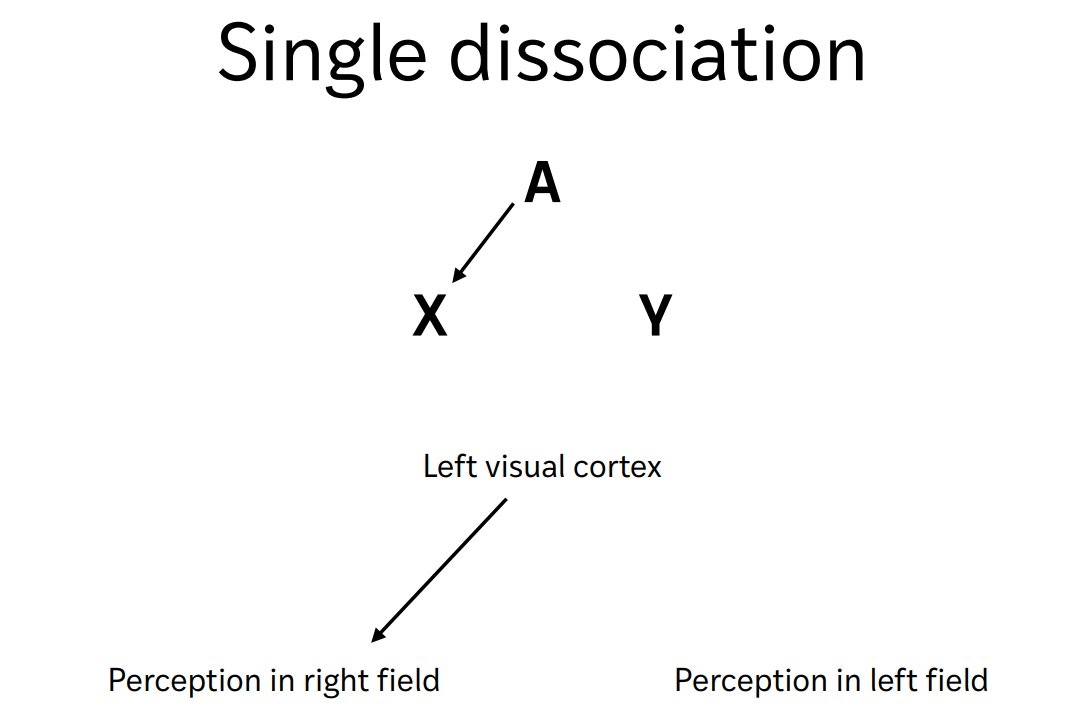
double dissociation
two independent comp processes A and B
two beahviors X and Y that dpeend selectively on A and B
some lesions should only affect X and not Y
some lesions should only affect Y and not X
by showing that it is not differnces in demand (one process doesnt always leave first), show that must be two independent processes
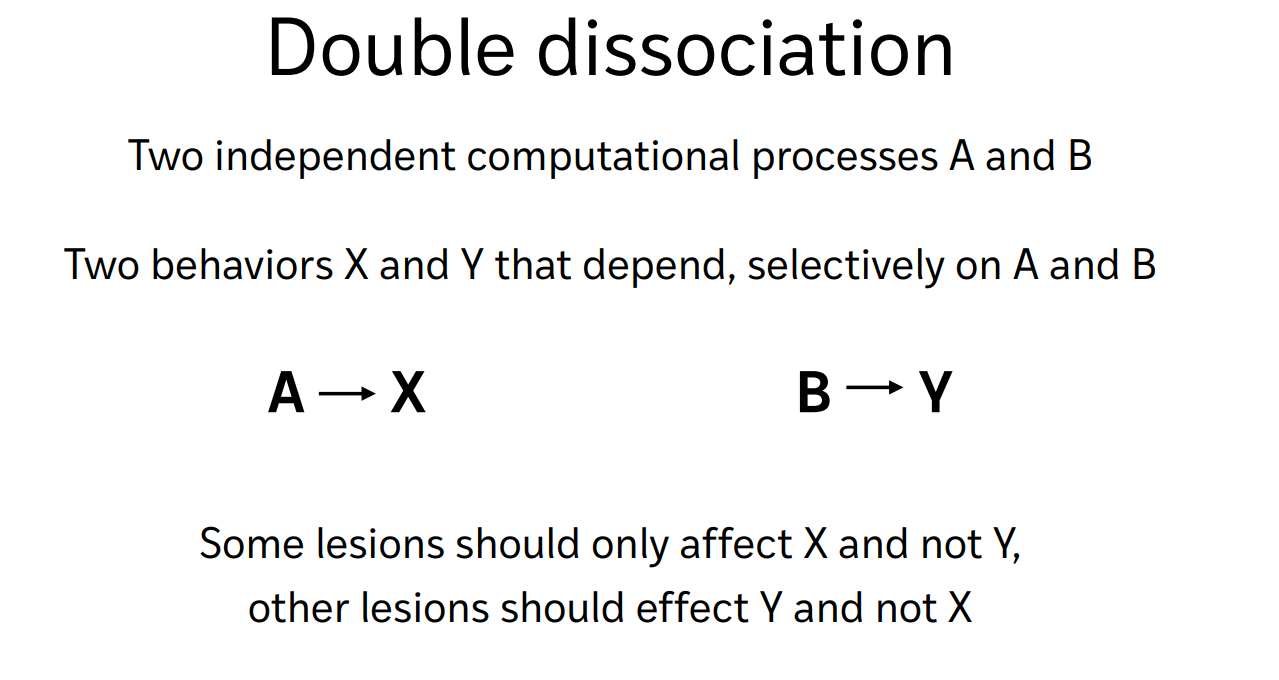
double dissociation in language
Broca’s Aphasia (expressive aphasia)
preserved language comprehension, but short and grammatically impoverished productions
(know whats going on, cant say it)
Wernicke’s Aphasia (fluent aphasia):
poor comprehension, fluent speech with relatively little content
(dont understand language, but can easily speak a bunch of words, no meaning to the sentences tho)
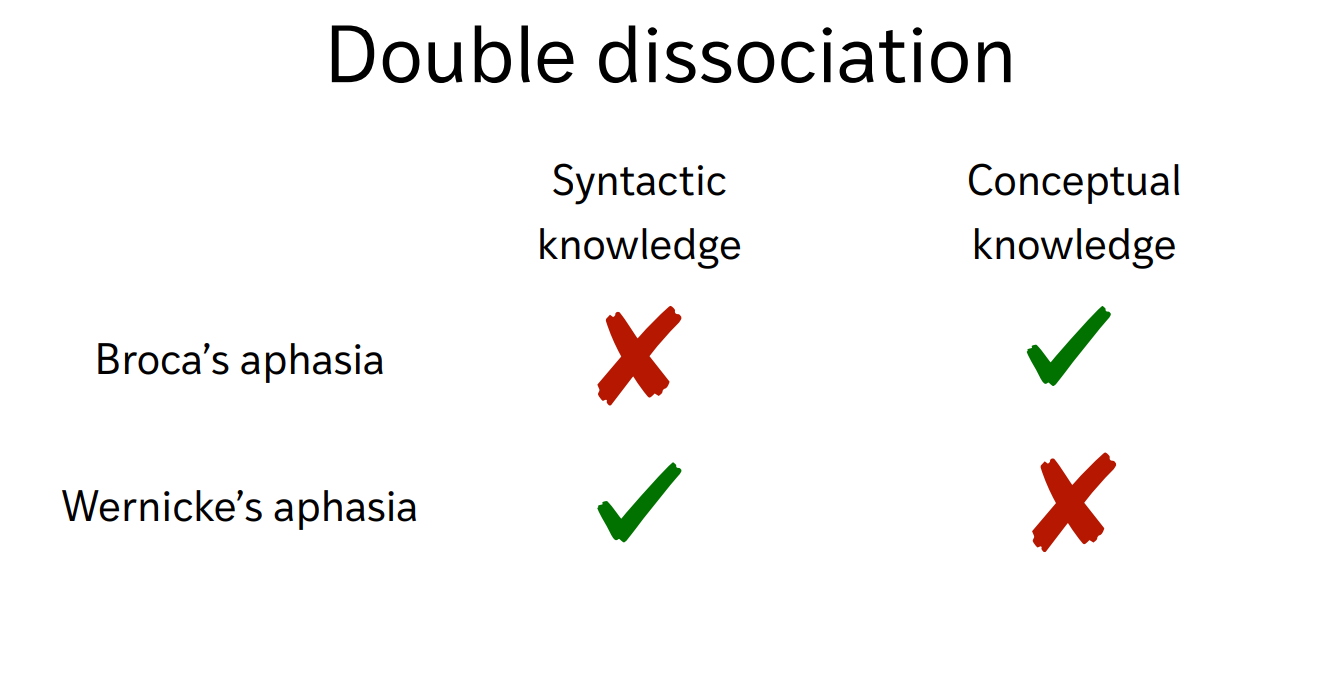
most brain lesions are not well localized —> CTE study
deceased former football players
88% with neurological condition had CTE
limitations of natrurally occurring lesion studies
subject to the whims of nature
correlational
not always well localized
observational studies —> correlation
naturally occurring lesions
electrical recording (electrocorticography)
neuroimaging (PET, fMRI, EEG)
interventional studies —> allow us to infer causation
surgical lesions
transcranial magnetic stimulation
transcranial direct current stimulation
transcranial magnetic stimulation (TMS)
repeated pulses of electrical stimulation for a period of time (15 min)
disrupts neural circuits for a longer period of time after that (~30 min)
self control study: apply TMS to prefrontal cortex
small reward now or wait and large reward later
when PFC is “lesioned” (TMSed) there is reduced preference for the larger-later option —→ more impulsive decisions made
advantages of TMS
temporary “lesions”
directly affects action potentials
excellent temporal resolution
not great spatial resolution
can establish causality
disadvantages of TMS:
only cortical surface can be affected
variability in brains btwn participants hurts spatial resolution
neural map examples
motor and somatosensory cortex are topographical maps of the body sensor and motor
closer in space, closer their neural representations are
retinotopic map:
visual cortex as a map, represents the retina in space
stained cat neurons while forced to look at moving stimulus map pattern
pts close in visual field are close to each other on VC
auditory map:
auditory cortex sits in small part of brain behind temporal lobe
tonotopy
f(sound frequency) = space on the brain
how are neural maps formed? innate vs experience
study of musicians and cab drivers
musicians:
professional musicians have more grey matter esp in primary motor cortex
non-musicians have less
cab drivers:
plasticity in the hippocampus
cab driver exam must be able to mentally simulate path from one location to another
found relationship between how long one has been a taxi driver and how big their hippocampus is
are these studies causational? NO
“the experiments show that expreience causes structural changes in the brain” = FALSE
no manipulation done —> causality cannot be established
experimental manipulation to show cat has orientation sensitive V1 neurons
cat raised in environment where only vertical or only horizontal lines
vertically reared
doesnt seem to have neurons that respond to horizontal lines
horizontally reared
doesnt seem to have neurons which respond to vertiacal lines
so: visual cortex isnt intrinsically set up to do this, interacts with environment
^^ double dissociation experiment
shows experience dependent plasticity = our brains refelct our experience / our brains ARE our experience
perception
Perception: experiences resulting from stimulation of the senses
Vision
Hearing and touch
Taste
Smell
Balance
Temperature
Proprioception
Pain
Interoception
Vision main takeaways
bottom up vs top down
object perception (bayesian inference)
gestalt grouping
why are faces special?
bottom-up visual processing
data driven
eye-to-brain
integrates basic features in the environment
top-down visual processing
based on prior experiences
uses prediction
input is interpreted using context
ex: THE TAE vs CHT CAT
interpret middle letter differently based on context of surrounding letters and overall word
evidence from neuroscience for top-down and bottom-up
though there are many connections from low to high in the visual perception wiring diagram, the great majority of these pathays involve reciprocal connections btwn areas
if there are projections from low to high area, there are usually just as many feeding from high to low
Bayesian inference is the combination of
(helmholtz) unconscious inference
and
contextual regularities
helmholtz unconscious inference
perception is a form of inference —> we see the object that is most likely causing the stimulus we observe (the likely principle)
— relates to the task of determining the object responsible for a particular image on one’s retina: the inverse projection problem
REMEMBER: are children actually small or just really far away SNL sketch
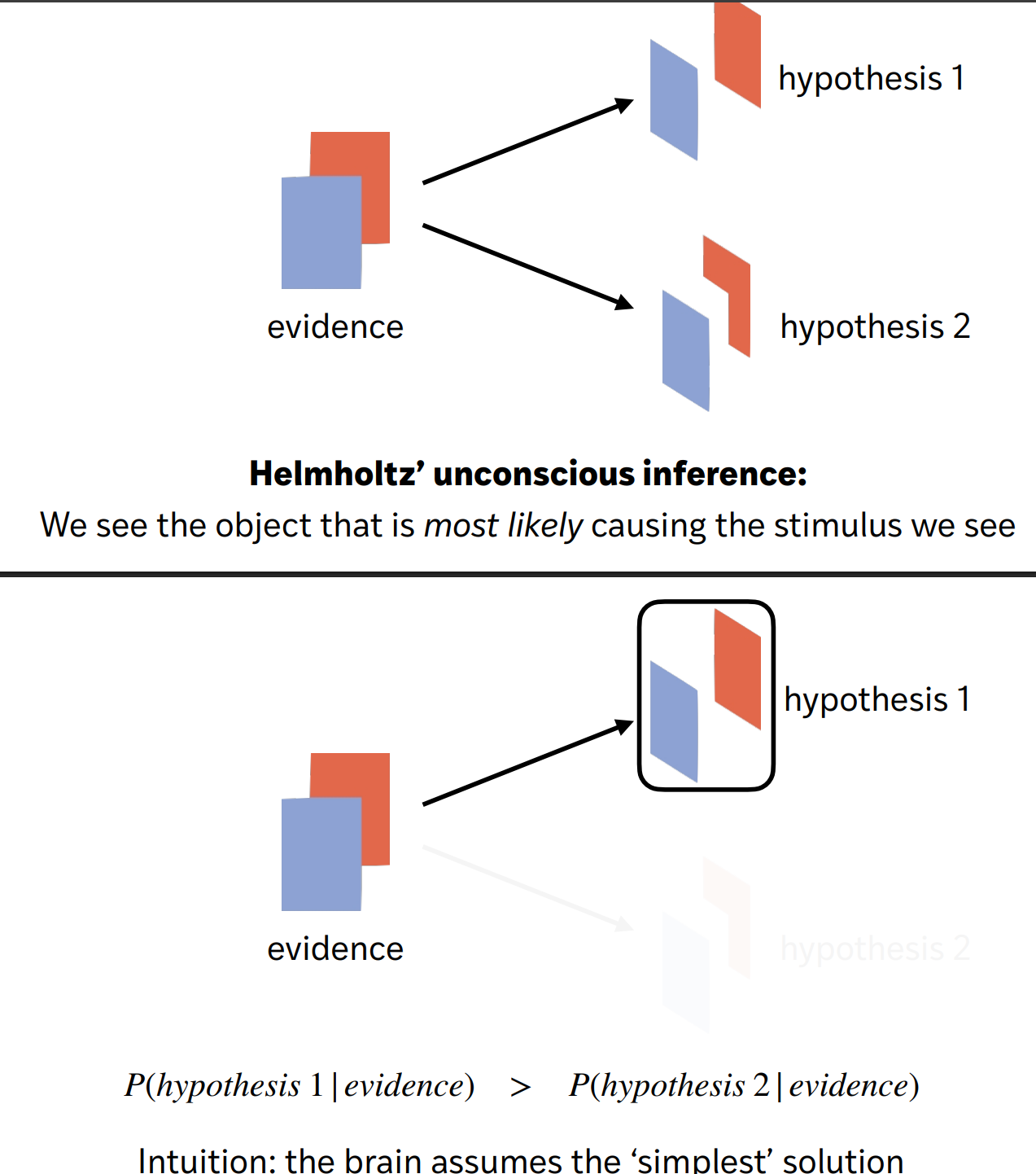
contextual regularities — AND Oliva & Torralba “multiple personalities of a blob”
physical regularities:
there are more vertical and horizontal edges than oblique (diagonal) edges
Light usually comes from above
Biological things are often roughly symmetric
Movement starts and stops smoothly
Objects don’t blink in and out of existence
semantic regularities
oasters appear more often in kitchens than in bedrooms
Pants are more likely to be worn on legs than on the head
Glass is more likely a solid than liquid
Multiple personalities of a blob: we use the context of the image to shape our perception of the ambiguous blob
Bayesian inference
P(H|E) = P(E|H) * P(H) / P(E)
P(H|E) —- posterior probability of hypothesis given evidence
bayesian inference compares these
P(E|H) = likelihood of evidence given hypothesis
P(H) = prior probability (before evidence)
P(E) = marginal probability, prob of evidence (usually can be discarded)
choose hypothesis which has highest posterior probability
on beach and see shape? is it driftwood or an umbrella?
prior is dictated by regularities
comparisons of posterior probabilities is unconscious inference
from far away, priors determine what is percieved
once closer, visual info outweighs the priors
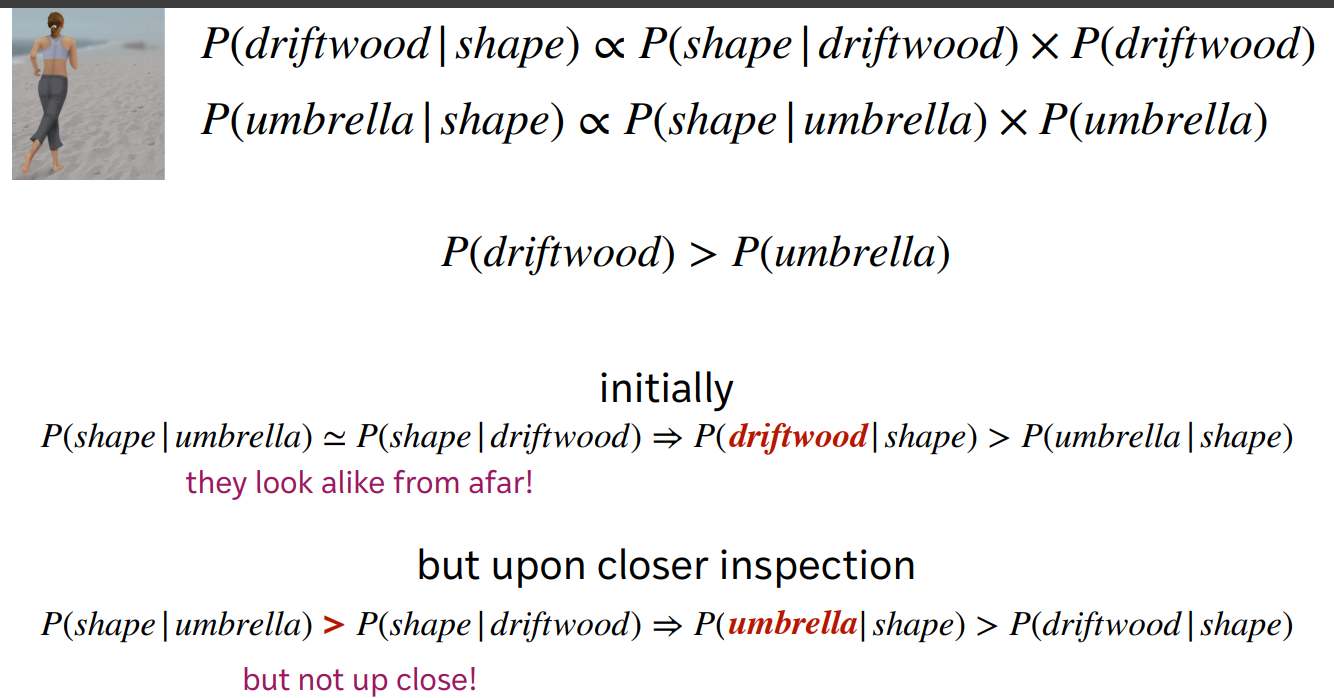
Gestalt Grouping
Gestalt = a shape, configuration, or structure which as an object of perception forms a specific whole or unity, incapable of expression simply in terms of its parts
Gestalt principles are TOP-DOWN processing
quick and automatic
reflects regularities in the environment and the likelihood principle
proximity (gestalt)
objects tend to be grouped together if they are close to each other
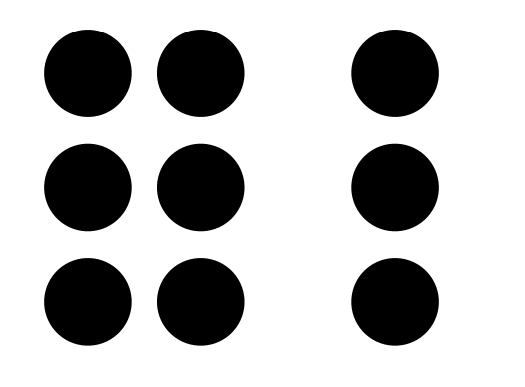
closure (gestalt)
tendency to complete figures or forms as a whole, even if information is sparse
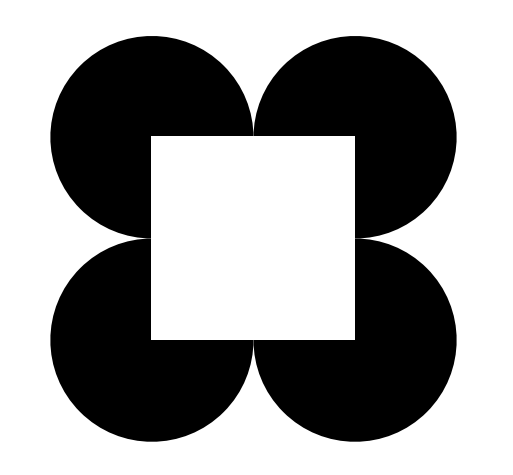
good continuation (gestalt)
tendency to parse figures with smooth, continuous lines, rather than abrupt or sharp angles
ex: this x is two straight lines, not two V shapes
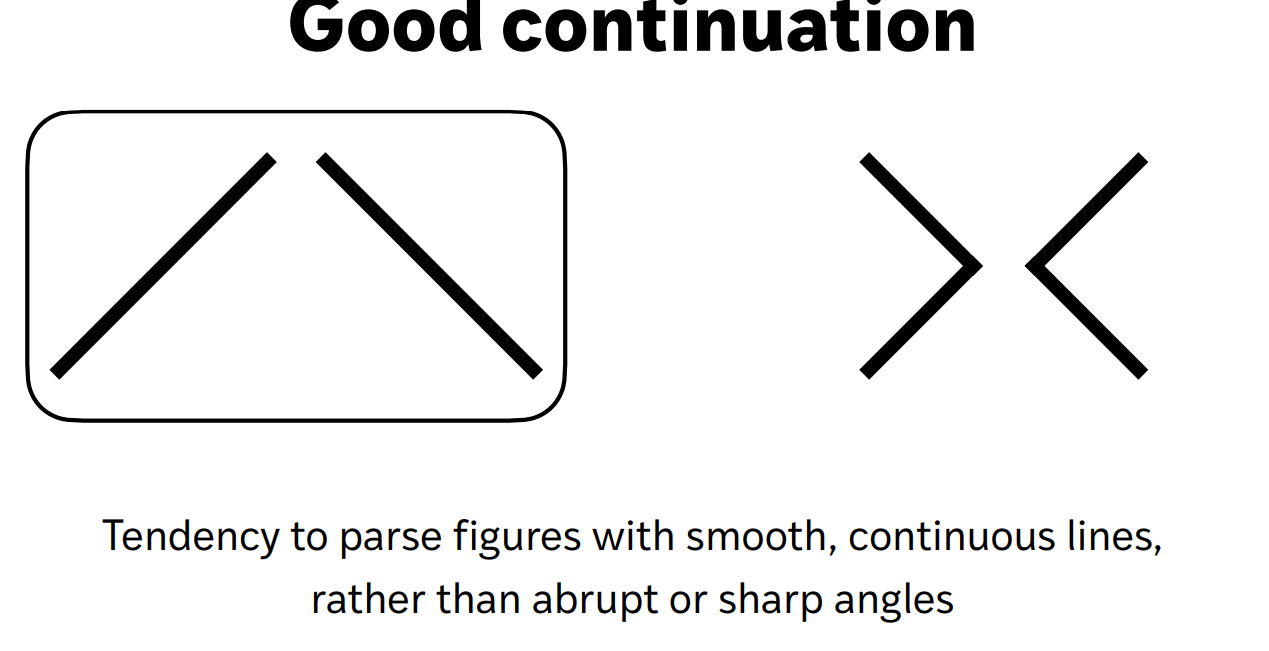
good figure (gestalt)
patterns are interpreted in such a way that the resulting structure is as simple as possible
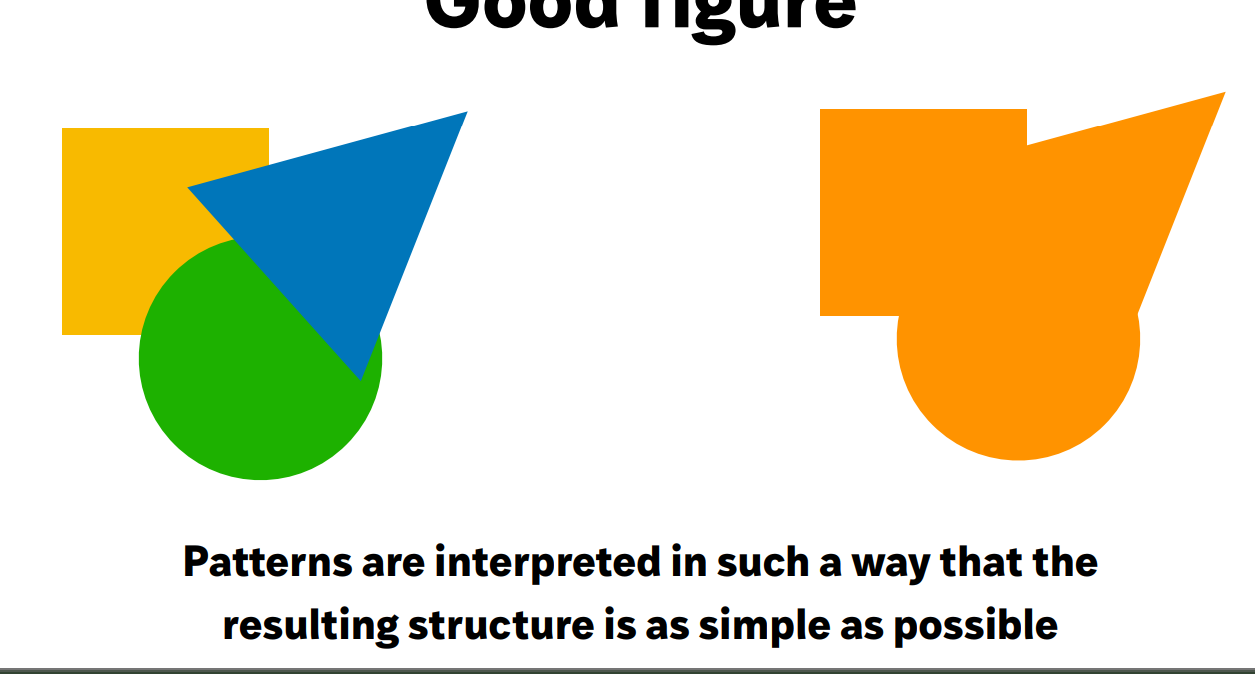
similarity (gestalt)
tendency to group objects together if they are similar
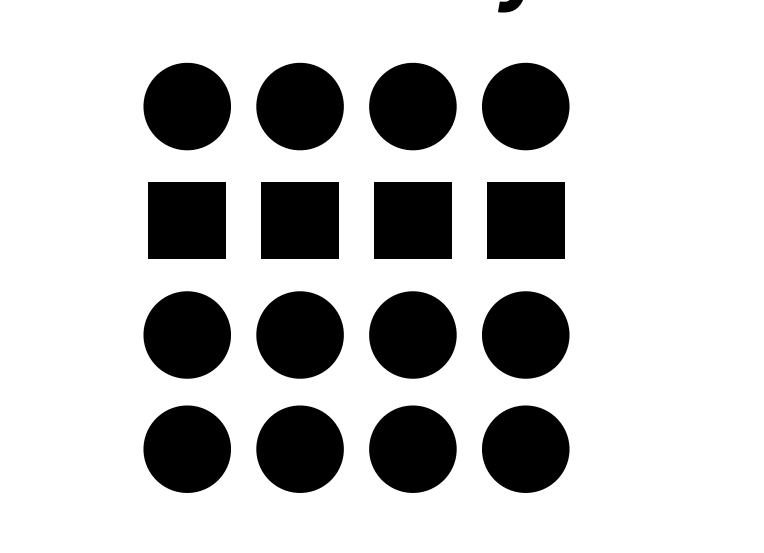
familiarity (gestalt)
tendency to group objects that are familiar or meaningful
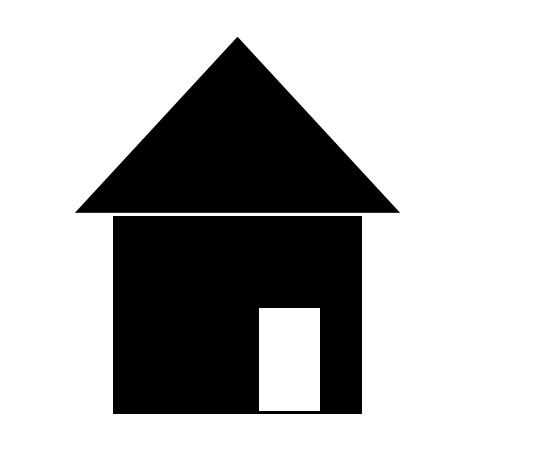
are faces special? is there an innate hardwired face module or is it experience dependent plasticity?
arguments for innate hardwired face module
hollow face illusion (bayesian inference, more likely to see outward facing face than hollow face)
thatcher effect (upside down face with right side up eyes, we dont notice anything wrong)
prosopagnosia (some ppl born w inability to recognize/detect/distinguish ffamiliar faces bc of damage to FFA / fusiform gyrus)
stimulating the FFA using implanted electrodes (when stimulating FFA, induces action potentials, causes patient to temporarily have difficulty recognizing face)
face selectivity in infants fMRI experiment (are we born with FFA? infants and parents in fMRI shown faces and places. in adult see specialized areas FFA and PPA. in infant, we also see that)
arguments against innate hardwired (FOR experience dependent plasticity)
greebles experiment (trained to become expert at analyzing made up creatures. after training, increased FFA response to Greebles creatures)
face deprivation study (raise monkeys never seeing researcher face or other monkey faces before. show them face in fMRI, no face area activation for ones that have never seen a face. Hand selective region responds tho.
for free-viewing behavior (images w both hands and feet showing), deprived only looked at hands. non-deprived looked all over at faces and hands
speech segmentation is
organizing the sounds of speech into individual words
TOP-DOWN processing that influences simple perception. need knowledge of ur language to know when words start and stop
maps for touch AND the two point discrimination task
somatotopic map
homonculus
two point discrimination task
different sizes of objects with arched edge and flat edge. start large. touch thing to body area and ask person if it was the arched or flat edge. then go smaller and see what is smallest threshold they can detect
lower the threshold, the finer the representation of that body area in the somatosensory cortex (ex, fingertips, tongue, lip, are very sensitive)
object perception in touch (quarter trick) — bayesian inference
two far away regions on two different fingers are feeling coin, so you are more likely to believe that there must be two coins rather than one coin bc two coins are more likely to make u feel that sensation in those two areas
hearing anatomy
air vibrations sound —> eardrum —> mechanical wave makes bones move —> fluid wave into cochlea —> hair cells vibrate for specific frequencies
high frequencies travel less
low tones travel more —further into cochlea
—> cells in brainstem —> … —> auditory cortex “heschl’s gyrus”
auditory cortex (as a map)
tonotopic map
use fMRI and play high and low tones and see which areas light up
map bc we see certain colors in cetain areas, pitch to spatial representation
plasticity in the auditory map
play 2 tones, which is more familiar
most ppl choose tone 2. why? it is the bleep noise tone on TV!
then play og tone in video 1 and either a sharp or flat tone in video 2
ask which has the correct tone now
the further away (in semitones) the wrong tone was, the more likely they got it correct
this bleep noise is not a commonly occurring frequency… we have been trained to know it (plasticity)
gestalt grouping in hearing
good continuation: gliding tone with small gaps in between. then filled with white noise. we fill in the gaps to hear smooth continuous gliding tone
proximity: hear a progression of notes that jumps from high and low a lot, instead of hearing jumping, we group high parts as the melody and low parts as the baseline
crossmodal perception
combining senses / interaction btwn senses
examples of crossmodal perception
McGurk effect
Rabbit Illusion
Rubber Hand illusion
McGurk Effect (crossmodal perception)
vision modulates hearing
interaction between top-down and bottom-up processing
bottom up thinks ba
vision comes in and makes u think fa
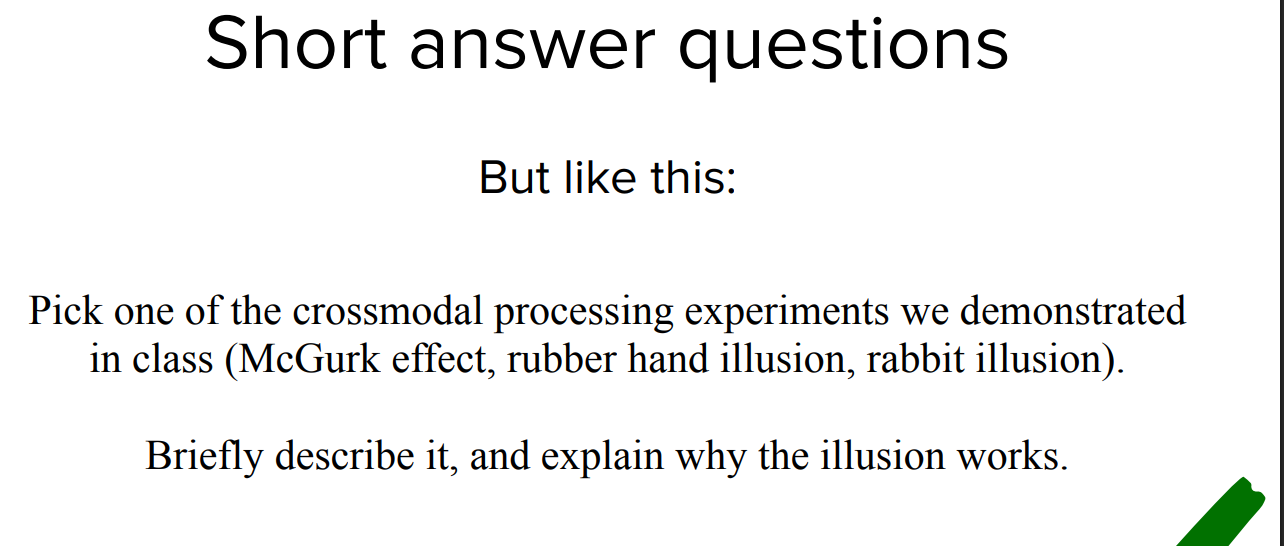
rubber hand illusion (crossmodal perception)
researcher brushes rubber and real (concealed) hand at same time, but participant only sees the fake hand
over time, participants report thtat they can feel touch in the rubber hand. even when no stim of real hand anymore
mental chronometry
determining the amount of time needed to carry out various cognitive tasks
skeptics about mental imagery think it is an
epiphenomenon